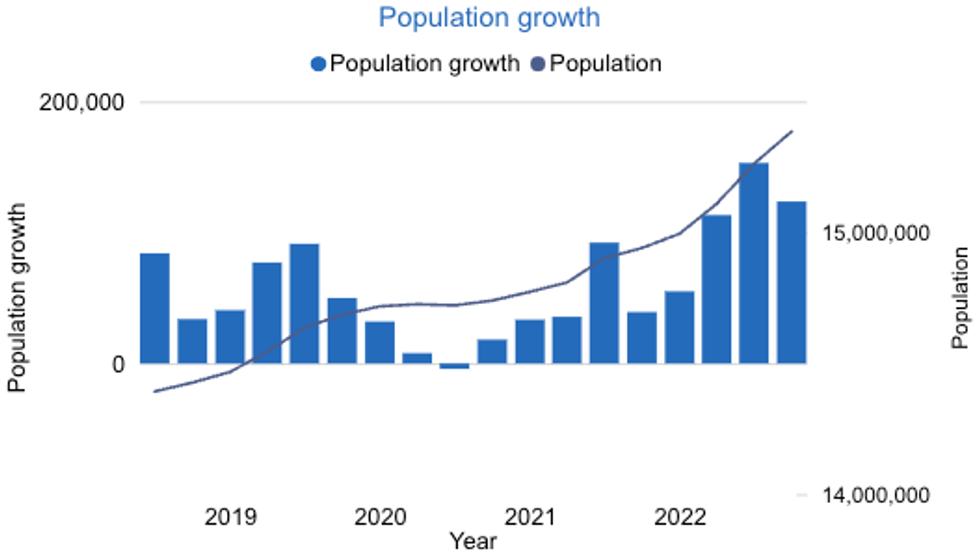Canada's Population Just Hit 40 Million & Here's Where The Country Has Grown The Most
Northwest Territories is a major outlier. 👀

A crowd of people in downtown Toronto.
Canada's population is experiencing a remarkable boom right now. Statistics Canada disclosed on Thursday that the country's population would hit the 40 million mark on Friday, with provinces such as Ontario and Alberta doing a lot of the heavy lifting.
The data was compiled using the agency's population clock, which models population growth in real time using various factors such as birth rates, death rates and migration data.
Canada's impressive 2.7% population growth rate — the highest amongst G7 nations — represents its most significant expansion since 1957, when the country experienced a population surge of 3.3% due to immigration and the baby boom.
Of course, not all regions in Canada have experienced the same population growth. For example, the Northwest Territories has most recently reported a decrease in population in the fourth quarter of 2022.
Below is a list of growth data for all the provinces and territories in Canada. The data highlights numerous factors, including the percentage that each province or territory's overall population represents in the country.
Ontario

Ontario's population growth chart.
Population as of January 1, 2023: 15,386,407
Population growth from October 1 to December 31, 2022: 123,747 (+0.8%)
Share of the overall population of Canada: 38.9%
Alberta

Alberta's population growth chart.
Population as of January 1, 2023: 4,647,178
Population growth from October 1 to December 31, 2022: 45,864 (+1.0%)
Share of the overall population of Canada: 11.7%
Quebec

Quebec's population growth chart.
Population as of January 1, 2023: 8,787,554
Population growth from October 1 to December 31, 2022: 36,202 (+0.4%)
Share of the overall population of Canada: 22.2%
British Columbia

B.C.'s population growth chart.
Population as of January 1, 2023: 5,399,118
Population growth from October 1 to December 31, 2022: 30,852 (+0.6%)
Share of the overall population of Canada: 13.6%
Manitoba

Manitoba's population growth chart.
Population as of January 1, 2023: 1,431,792
Population growth from October 1 to December 31, 2022: 11,564 (+0.8%)
Share of the overall population of Canada: 3.6%
Saskatchewan

Saskatchewan's population growth chart.
Population as of January 1, 2023: 1,214,618
Population growth from October 1 to December 31, 2022: 9,499 (+0.8%)
Share of the overall population of Canada: 3.1%
Nova Scotia

Nova Scotia's population growth chart.
Population as of January 1, 2023: 1,037,782
Population growth from October 1 to December 31, 2022: 6,829 (+0.7%)
Share of the overall population of Canada: 2.6%
New Brunswick

New Brunswick's population growth chart.
Population as of January 1, 2023: 825,474
Population growth from October 1 to December 31, 2022: 4,688 (+0.6%)
Share of the overall population of Canada: 2.1%
Newfoundland and Labrador

Newfoundland and Labrador's population growth chart.
Population as of January 1, 2023: 531,948
Population growth from October 1 to December 31, 2022: 3,130 (+0.6%)
Share of the overall population of Canada: 1.3%
Prince Edward Island

Prince Edward Island's population growth chart.
Population as of January 1, 2023: 173,954
Population growth from October 1 to December 31, 2022: 1,247 (+0.7%)
Share of the overall population of Canada: 0.4%
Yukon

Yukon's population growth chart.
Population as of January 1, 2023: 44,238
Population growth from October 1 to December 31, 2022: 274 (+0.6%)
Share of the overall population of Canada: 0.1%
Nunavut

Nunavut's population growth chart.
Population as of January 1, 2023: 40,692
Population growth from October 1 to December 31, 2022: 106 (+0.3%)
Share of the overall population of Canada: 0.1%
Northwest Territories

Northwest Territories' population growth chart.
Population as of January 1, 2023: 45,493
Population growth from October 1 to December 31, 2022: -109 (-0.2%)
Share of the overall population of Canada: 0.1%
If the country's current growth trajectory persists, projections indicate that Canada's population could reach 50 million by 2043, Statistics Canada predicts.
"This is an exciting milestone for Canada," Chief Statistician Anil Arora said in a news release. "It is a strong signal that Canada remains a dynamic and welcoming country, full of potential. As we head into Canada Day, this is certainly cause for celebration!"
A growing population might initially seem like good news for the country. However, it becomes less ideal when considering how unaffordable things have become.
In April 2023, Statistics Canada reported a 4.4% year-over-year increase in the cost of living — slightly higher than the 4.3% increase in March.
April marked the first uptick in CPI from the downward trend seen since July 2022. The primary drivers behind this overall price increase were higher rent and mortgage interest costs compared to the previous year.